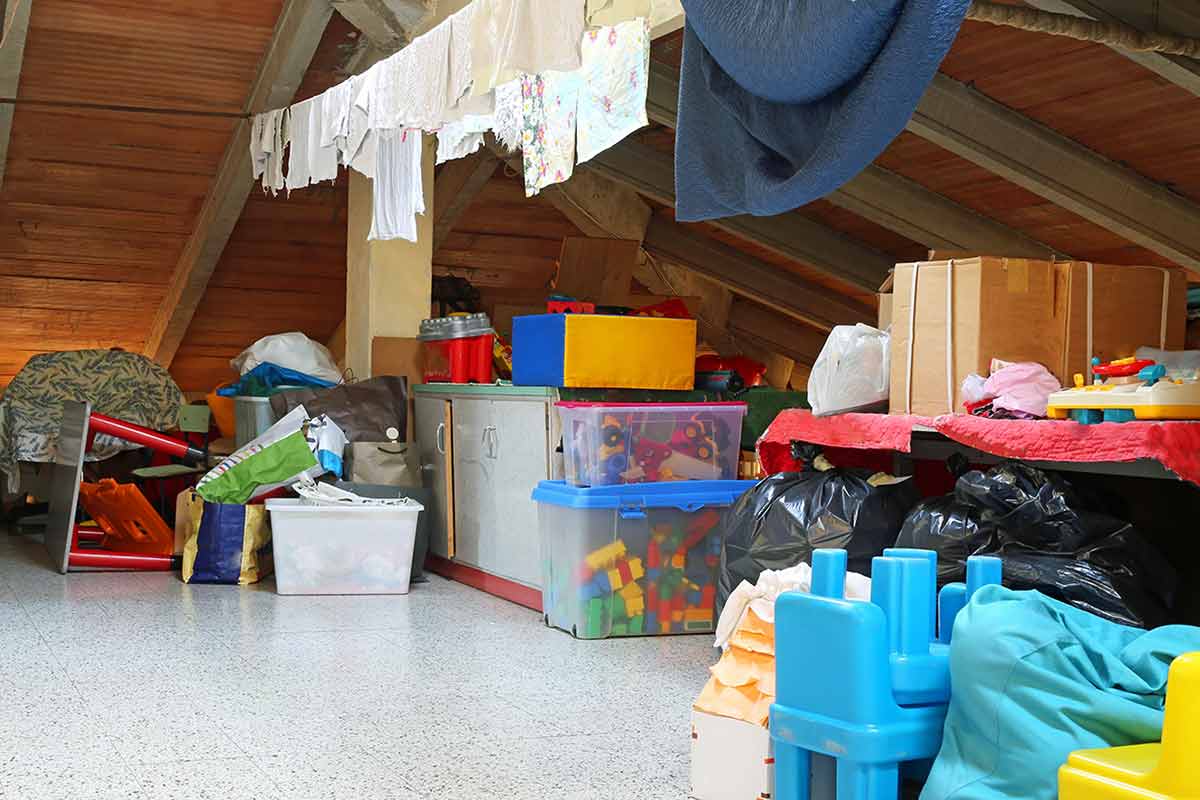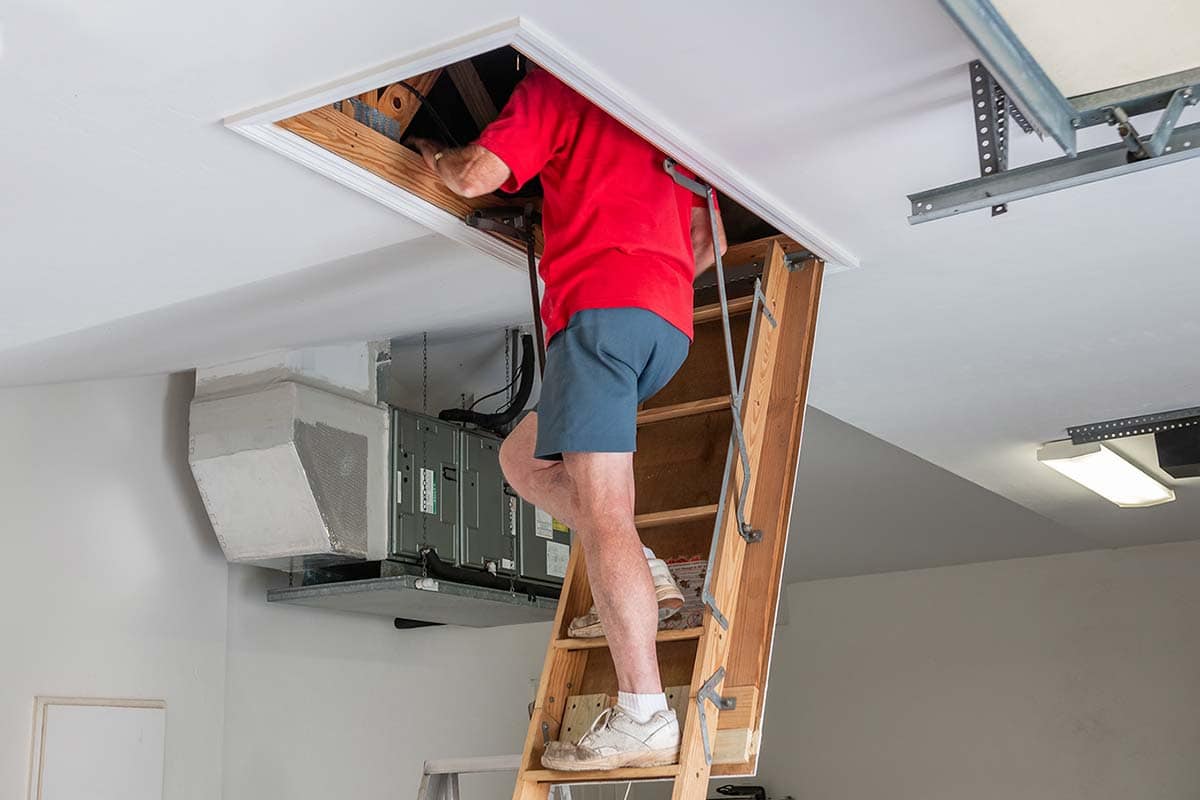It's so easily forgotten, but if you're a homeowner, there's a good chance you have some kind of attic space. You may shrug off the space over your head, but there are plenty of ways that an attic can contribute to the quality of your home.
We want you to get the most of your home, and as one of the most underappreciated and underutilized areas in it, your attic is likely a prime target for some extra attention. We'll cover your attic top-to-bottom and beyond, letting you know where you can find potential.
Disclaimer:
All, or some of the products featured on this page are from our affiliated partners who may compensate us for actions and or sales completed as a result of the user navigating the links or images within the content. How we present the information may be influenced by that, but it in no way impacts the quality and accuracy of the research we have conducted at the time we published the article. Users may choose to visit the actual company website for more information.
Attic Meaning
An attic is the empty space that you will find above the top storey of a residence but below the roof.
The insulation in your attic is what keeps you warm in the cooler months and cooler in the warmer months. The attic space contains the framing for your roof design and support system. Attic sizes depend on the slope of the roof and square footage of the floor.
The attic is the space under the roof and above the ceiling. Typically attics are dark spaces with square door access usually found in closets - however this article expands on that in great detail further on.
The average Canadian attic is an unfinished area separating a flat ceiling from a sloped roof. Most Canadian homeowners often convert their attics into extra storage rooms. But some homeowners prefer to finish their attics and transform them into extra space or mini rooms, but doing so often requires extensive renovations.
What Is the Purpose of An Attic
The attic's purpose is primarily to hold insulation, keeping the livable area below comfortable. It can also provide storage, hold HVAC equipment, or turn into another livable room in some cases.
The shape of the attic commonly comes from a gable design, an increasingly popular style across much of North America. It's a practical form for Canadian homes, keeping harsh winter weather from damaging our roofs while maximizing the usable attic area.
One essential job of an attic is to support the roof, so you may see them with exposed joists and framing. There are two types of frames that builders use to handle the structure — rafters and trusses.
Rafters
Rafters are long 2x10 or 2x12 boards that maintain the slope of the ceiling. A ridge beam that runs the length of the attic meets the rafters at the roof's peak, connecting all the rafters to support the load.
For extra strength, there may be collar ties running between rafters at a high point, giving the interior an "A" shape. These usually sit high, close to the ridge board.
Rafters are built on-site and installed one at a time. The ceiling joists, which hold the ceiling for the top storey and create the flooring support for the attic, run the width of the attic to connect the rafters near their base.
When constructed with rafters, an attic will have a more open space, one ready for renovation if you plan to turn it into a livable space.
Trusses
Unlike rafters, trusses are pre-fabricated roof supports, with the roof supports already connected. They are extremely strong, less expensive to install than rafters, and able to go up in a day.
Trusses are built with a series of struts that support the rafters from the attic's floor, usually in a "W" shape. Unfortunately, because these necessary structural features fill the attic, it's nearly impossible to renovate the space into a livable room. The structure of your attic should be an important consideration when it comes to buying a house, especially if you want free reign to make changes.
Different Types of Attic
Most Canadians use and design their attics in different ways. But surely most (if not all) homeowners with attics want their attics to be as energy-efficient as possible. Below are the different types of attics:
Scuttle Attic
A scuttle attic is one that is accessed by a hole in the ceiling and which is typically covered by a latched door of some sort. Older homes used to be built with stairs leading up to the attic and more often then not the space was used for storage. Newer homes however don't have stairs leading up to attics anymore unless of course the builder intended on that area being used as a living space. Now, it's not uncommon to find attic ladders leading up to this space. Even attics with scuttle access have use though. The 2012 residential building code requires that any attic, even with scuttle access that are 30 square feet and a peak height of 30" have some sort of entry. For the scuttle holes, the minimum opening size requirements are 22"x30".
Unfinished Attics
The primary difference between this type of attic and a scuttle type is that the unfinished attic is accessible through a permanent staircase rather than a ladder and trap door. This type of attic is not for use and is not decorated for use. Attics are usually unfinished in order to seal them off from the main living space below. Most people will ensure that they are well insulated over the floor joists. Before insulation, it's important to close off any air leaks. Also, even though you may not be using the space for anything, it's important to ensure that your unfinished attic is safe. Here are some great ways to test it out:
- Look for signs of pests. These can include bees or wasp nests, mice droppings and even raccoons and squirrels.
- Check the insulation. In the 1970's and 80's vermiculite insulation was used and is well known for asbestos. This is a known carcinogen to humans. If you see black spots or disintegrating areas, contact an asbestos removal professional immediately.
- Look at your wiring. As with asbestos, always leave the electricity to a professional. If old wiring is near your insulation, this could be a potential fire hazard.
- Walk safely. Putting one foot on one joist at a time will help to keep your balance and spread your weight out. Always minimize any tripping hazards.
- Bring an extra light source. Bringing a flashlight up with you is a great idea. Even in the light of day, attic corners can be quite dark.
- Check the weather. Attics can become dangerously hot in the summertime and chances are if your attic is unfinished, you don't have proper ventilation installed.
- Dress for it. Protect your skin from any irritants by wearing long pants and a shirt and of course, wear an N95 mask to protect your respiratory system from any fine particles floating around up there.
- Look for a floor. While this may seem like a no brainer, many people have thought that the ceiling for the room below is sufficient support. It's not. Avoid serious injury and ensure you are actually stepping on the attic floor. Not sure, again, call the pros
Partially Finished Attic
A partially finished attic is just that - not quite done yet. However in order for it to be considered partial, the area has to be equal to 20%-39% of the homes main floor square footage. In homes which feature steeply sloped roofs, there may only be a small area with enough headroom to live in. Some homeowners may opt to make a small livable space in a partially finished attic and leave the rest for storage.
Full Finished Attics
This type of attic has a living space of 40%-54% of the home's main floor square footage. The decision to fully finish your attic is a big one however. Typically new homes these days have sloping roofs which mean that like partially finished attics, only a small portion of it may actually be usable. Taking a Cape Cod style home for example may not actually provide a space large enough to create an entire bedroom, but may be perfect for a small study with bookshelves
Full Finished Wall HGT Attics
This type of attic has a livable and fully decorated area equal to 55% or more of the main body ground floor of the attics. Normally, the wall is also decorated for storage or other needs. This type of attic is equipped with plumbing, HVAC and electricity.
Attic Renovations
A shallow sloped roof and trusses are good indicators that you won't be able to remodel your attic. But if you have a steep roof that raises the attic's ceiling via rafters, you should be able to make the conversion. It also helps if it's a gable-style construction with flat walls at the ends of the attic to make space.
Attic renovations can usually be done if you have enough area for people to operate in, but there are numerous additional considerations to determine if your plans are possible.
To start, you'll need to check your local and provincial building codes to ensure your attic meets the requirements for a livable room. In terms of space, your attic needs floors at least 70 square feet in area and 7 feet wide, and the ceiling must be at least 7 feet high.
Once you have determined the space, you'll need to consider key details of the attic before renovating, including:
- Insulation
- HVAC
- Electrical wiring
- Flooring
- Windows and skylights
- Access features
- Weight capacity
It's best to talk to a structural engineer before arranging any changes to your attic. If you plan to turn it into a livable space, you may want to add bathrooms, closets, or fixtures that may not meet code. But when you find that your attic has the right structure, it could be a budget-friendly renovation opportunity.
Attic Insulation
Attics fall into two categories, conditioned and unconditioned, which largely dictate how they are insulated.
Conditioned Attic - It is climate-controlled, with heating and cooling ducts reaching it from the HVAC system.
Unconditioned Attic - It is not climate-controlled and will need significant work to turn into a livable area. If you have a conditioned attic, it falls within the building envelope, the insulated seal around a house containing the temperature-controlled living space. In this case, as part of the envelope, the attic will have insulation in the ceiling between the rafters.
Attic ceiling insulation is commonly batt insulation, the familiar pink fiberglass blanket rolls fitted with a vapour barrier that attach to the ceiling between the rafters. Insulation is rated by R-value, with higher values indicating lower heat transfer and subsequently better performance. In our cold Canadian climates, you'll need a high R-value in the attic, usually between 50-60, to keep the heat in.
Other options for insulating a ceiling include rigid foam board and spray foam. Spray foam is ideal because it provides a high R-value while sealing air gaps, which need to be fixed before you add any kind of insulation.
In an unfinished attic that can't have renovations, insulation will go between the floor joists, putting the attic outside the building envelope. This is crucial because as heat rises to the attic, it pulls cold air into the livable space below and will make your HVAC work harder to keep a consistent temperature.
Insulation on the floor can either go down as batt rolls or loose fill that is blown in. Snow-like loose fill is an economical way of getting excellent R-value while filling air leaks that batt insulation can't reach.
Attic Insulation Cost
Blown-In Insulation, which you'll commonly find in either cellulose or fiberglass varieties, can fill any small nook or cranny and is inexpensive at around $1.60 per square foot. The fill can go in ceilings, but you'll more commonly find it in unfinished attics resting on the floor.
Fiberglass Batt Insulation is easier to work with than loose fill. It works well for ceilings and is one of the cheapest options at around $1.20 per square foot. The downside is that you don't typically get as good of an R-value out of batt insulation and may need to reinforce it.
Rigid Foam Board is a step up from fiberglass batt, offering better R-values and heat deflection features. Low-end options can cost around the same as fiberglass batt insulation, but they can get over $2.00 per square foot for higher R-values.
Spray Foam is the most expensive option, costing up to $3.50 per square foot. But if you want the best insulation for your finished attic, spray foam not only fills any hard-to-reach air leaks but also delivers the highest R-value.
Insulation costs will also vary with labor. Batt and foam board insulation can be more of a DIY project if you feel confident putting it up. Blown-in and spray foam insulation will generally require professional help, which will add to the overall costs.
Attic Ventilation
Your attic's ventilation is usually a passive system made up of the perforated soffit that sits under the eaves on the outside of your house and a ridge beam vent at the top of the attic. The process works by convection, where warm air rises through the ridge vent at the top and the suction created by that motion pulls in air through the soffit.
Keeping moisture out of your attic is crucial to regulate humidity and prevent mold and rot in the upper frame. In colder climates, this also helps prevent ice dams from forming on your roof.
An important part of ventilation is also proper seals around the attic. Air leaks not only allow moisture and pests to sneak in but can also tax your HVAC system. Ensuring your attic is sealed is critical whether you finish it or not.
Attic Fan
If passive ventilation isn't doing the trick, an attic fan could be a valuable installation. These help the passive ventilation system keep the air cool in the attic. They operate on an automatic switch, where a certain temperature in the attic activates the fan.
Attic fans are not ideal for all houses, but they come in handy if you have poor attic insulation. In both hot and cold climates, they are ideal for keeping moisture to a minimum and protecting your structure and any HVAC equipment in the attic.
Attic Ladder
Access to the attic can range from a hole in a closet ceiling to a full staircase leading to a door. Of course, if you plan on doing an attic renovation, the hole in the ceiling will need a serious overhaul before it can be a suitable living space.
A pull-down ladder or folding stairs configuration often extends into a hallway on the top storey. If you plan to convert the attic to a livable space, you may be able to change the setup to a straight or spiral staircase. It's critical to reference building codes to make sure you are following the rules for tread width and depth, rise, and head clearance.
Attic Windows
It's important to keep emergency exit routes in mind, especially if the attic is above the second storey of your home. That includes a safe and accessible entryway via stairs and any windows.
Windows are beneficial for letting in natural light and regulating heat, but they're also an essential secondary exit. While you're planning a remodel, you can consider installing windows on an end wall or add skylights. A more labour-intensive but space-creating solution would be to remove rafters to make a recessed window with more headspace.
Attic Bedroom
The exact definition of a bedroom will change from one province's building codes to the next. If you plan on renovating, it's critical to research the requirements so that you can make your home more marketable and raise the resale value. While some areas in Canada are more lenient on what qualifies as a bedroom, you will commonly find rules surrounding certain features, such as:
- Closet space
- Square footage
- Emergency exits or sprinkler systems
An attic bedroom is an excellent use of the space, but there is almost no limit to what it can become. For instance, its smaller size makes it a perfect playroom for the kids. Even better, you can turn it into a home entertainment or gaming getaway.
Finishing A Room
There's a lot of potential to an attic beyond making it one big storage area. But when you make it a livable space, you have to worry about its fixtures, insulation, access, and HVAC. If you want to add a bathroom, closet, or furniture, you need to make sure it can handle the weight as well.
Finishing an attic will typically entail adding drywall over insulated ceilings and walls, installing a subfloor, and laying flooring. You may have to install extra joists, struts, or rafters to finish the interior.
You'll also need to worry about heat, A/C, and electricity. Before finishing the walls and floor, your builder will have to hook up new ductwork to the existing system, which can require more extensive work on your home's livable area.
Wiring electricity may be an easier chore, depending on where you need outlets and if you have overhead lights. You can connect wiring to the breaker to make a separate zone, though this can be exhausting if the breaker is far away from the attic. A simpler route would be to add the wiring to an existing circuit on the top storey.
Protect Your Assets with Life Insurance
Click here to get a quote now.
Go to quoterAttic FAQs
Below are the commonly asked questions online:
If the attic is easy and safe to access, they should be inspected at least once a year. Obviously if your attic is a livable space then you would naturally take a look around more regularly. Doing regular inspections is also a great way to spot potential problems before they become very expensive issues.
By and far, the most common issues folks experience with their attics are signs of rodents. This is a big one as rodents carry certain diseases and bacteria which can be harmful to your family
Speaking of rodents, attics are a prime habitat for them.
These are common signs that you have rodents living in your attic:
- Excrement
- Gnaw and bite marks
- The smell of urine
- Nests
- Hearing activity - pitter patters, mating, squeals.
Here’s what to do if you’ve got rodents in your attic:
- Try to determine what kind of rodents they are. The droppings usually tell the tale. Mice will have small droppings and rats will have much larger ones.
- Do your best to determine where they have entered your home. Mice are masters of flattening themselves to get through tiny spaces. Check for gaps in your home around windows, vents, doors, pipes and even where wiring enters.
- Secure your food sources.
- Set live or snap traps and many of them. Ensure you are buying the right kind however as mice traps just anger rats. Very importantly, clean them out regularly. Rodents left for dead will eventually yield maggots which is a whole different problem altogether.
- If your trap system isn't working then call a professional
Under ideal conditions, fibreglass insulation will last up to 100 years.
But we know that no conditions are ever perfect, especially with some of the bizarre weather patterns we are seeing today.
The quality of the install, moisture and compression are all factors in determining the longevity of your insulation. Given those indicators, expect a 10-20 year lifespan.
Insulation is actually one of the more affordable costs of maintaining your attic. So when it starts to degrade, do call a professional installer and have it replaced.
Are You Brushing up on Your Home Owners Knowledge?
Check out our article on house foundations here.
View ArticleTaking Care of Your Attic
Your attic deserves your attention whether you use it or not. Without regular care and inspection, your attic may be costing you money and leaving your home open to damage without you realizing it. We want to ensure you keep your family safe and healthy, and in many ways, your attic is the first line of defense in that effort.
Have we inspired you to take a second look at the renovation possibilities of your attic? When you're ready to upgrade your space, contact our team at Insurdinary to learn how your rates may be affected and what you can do to get the best deals.








